- 1Department of Physics and Astronomy, Queen Mary University of London, London, United Kingdom
- 2Department of Physics, Hajee Mohammad Danesh Science and Technology University, Dinajpur, Bangladesh
Whistler mode waves are one of the dominant plasma emissions occurring in the Earth’s magnetosphere. Using data from the Magnetospheric Multiscale (MMS) mission taken in the outer magnetosphere, we present observations of a multiband whistler event with multiple discrete frequency bands of whistler emission. A newly developed bispectral analysis method, the normalized wavelet bispectrum, is employed to explore the generation mechanism of such whistler mode waves. This method is useful for examining the time-evolving behaviour of coupled oscillatory systems. The wavelet bispectrum analysis of multiband whistlers suggests that the higher-frequency whistler band is possibly generated due to a nonlinear three-wave coupling involving the two lower-frequency whistler bands. The presence of other features such as rising tones provides evidence that multiband whistler events probably involve several different concurrent emission processes.
1 Introduction
Whistler mode waves are intense electromagnetic emissions observed in natural plasma. A variety of whistler mode waves can exist in the Earth’s magnetosphere, including lightning-generated whistlers (Helliwell, 1969), plasmaspheric hiss (Bortnik et al., 2008; Ni et al., 2014; Summers et al., 2014), and whistler mode chorus (Burtis and Helliwell, 1969; Burton and Holzer, 1974; Li et al., 2012). There are incoherent, broadband emissions confined within the plasmasphere (from L-shell 1.6 to the plasmapause) or observed in regions of high-density plasma (e.g., plasmaspheric plumes) known as hiss (Bortnik et al., 2008; Ni et al., 2014; Summers et al., 2014). Plasmaspheric hiss spans the frequency range typically from
Recently, a special type of whistler mode wave event called multiband whistlers has been detected by satellite observations (Macúšová et al., 2014; Fu et al., 2015; Gao et al., 2016; Gao et al., 2017). Using Cluster spacecraft data, Macúšová et al. (2014) reported such a distinct type of whistler mode emission in the Earth’s magnetosphere at about L-shell 4.4 that contains more than three frequency bands leaving a frequency gap between any two bands. They reported that the frequency bands of these emissions can be composed of either individual chorus elements, structureless hiss, or combinations of discrete structures and hiss-like emissions. In the usual scenario, a frequency gap is observed in banded chorus at about half of the
Although a linear or quasi-linear mechanism may be sufficient for explaining whistler mode chorus or hiss, nonlinear processes play a crucial role in generating their multiband types. In this work, we will investigate one of the possible generation mechanisms of multiband whistler mode waves called nonlinear three-wave interactions. The non-linear three-wave interaction involving whistler mode waves is a common plasma wave phenomenon in the Earth’s magnetosphere (Gao et al., 2017; Teng et al., 2018; Gao et al., 2019). The idea of nonlinear three-wave interactions is the generation of a third wave due to the wave-wave coupling between two initial waves. Note that such interactions occur when three wave modes satisfy the following resonance conditions of angular frequency and wavenumbers,
The non-linear three-wave interaction between whistler mode upper band wave
Bispectral analysis has proven to be effective in investigating wave-wave coupling phenomena in both laboratory (Kim and Powers, 1979; Milligen et al., 1995a) and space plasmas [Dudok de Wit (1995); Bale et al. (1996)]. Bispectral analysis, initially presented as a method for unveiling time-phase relationships, has been extended to incorporate wavelets instead of relying on Fourier analysis. The wavelet bispectrum enables the detection of intermittent phase couplings, in contrast to the Fourier bispectrum, which tends to smooth out the majority of time-relevant information. Bicoherence is particularly crucial in bispectral analysis. This is because bispectrum values are influenced by both signal amplitude and the degree of phase coupling, whereas bicoherence values directly indicate the degree of phase coupling. Note that bicoherence is defined as the normalized amplitude of the bispectrum, providing an estimation of the degree of phase coupling present in a signal or between two signals. The bicoherence value is bounded between 0 and 1, where a value of 0 indicates random phases, while a value of 1 corresponds to total phase coupling. There have been a number of methods for estimating bicoherence including short-time Fourier transform based bicoherence (Kim and Powers, 1979; Bale et al., 1996; Hagihira et al., 2001) and wavelet bicoherence (Milligen et al., 1995a; Milligen et al., 1995b; Gao et al., 2016; Gao et al., 2017). Kim and Powers (1979) presented digital bispectral analysis techniques involving the computation of the third-order cumulant spectrum using fast Fourier transform to investigate non-linear wave-wave interactions in plasmas. In contrast, Milligen et al. (1995a), Milligen et al., (1995b) introduced a wavelet bicoherence analysis tool based on wavelet transform, specifically designed to examine turbulent or chaotic data and facilitate the identification of phase coupling between short-lived wavelets. It is worth noting that wavelet transform refers to the decomposition of a signal into wavelet components that depend on both scale (inverse of frequencies) and time. Recently, Newman et al. (2021) addressed certain limitations associated with the use of wavelet bicoherence, and these limitations are discussed in Section 4. To overcome these limitations, they defined the wavelet bispectrum by introducing a suitable normalization to examine the time-localized distribution of bispectral content over frequency-frequency space.
The purpose of this paper is to examine the wave-wave coupling phenomena in multiband whistler mode waves. We initially present an example of a multiband whistler mode wave event detected through MMS observations in the dayside Earth’s outer magnetosphere. Subsequently, we perform wavelet bispectrum analysis, following Newman et al. (2021)’s approach, to investigate the generation mechanism of such a multiband whistler.
2 Magnetospheric multiscale mission observations
Magnetospheric Multiscale (MMS) Mission is composed of a four-spacecraft constellation launched on 12 March 2015, flying in a tetrahedral formation with geocentric perigee and apogee at 1.2 and 12
Figure 1 displays the time-frequency spectrogram of the MMS event observed at 20:54:05 UT on 23 February 2021. From top to bottom, the figure shows magnetic power spectral density (B-PSD), electric power spectral density (E-PSD),
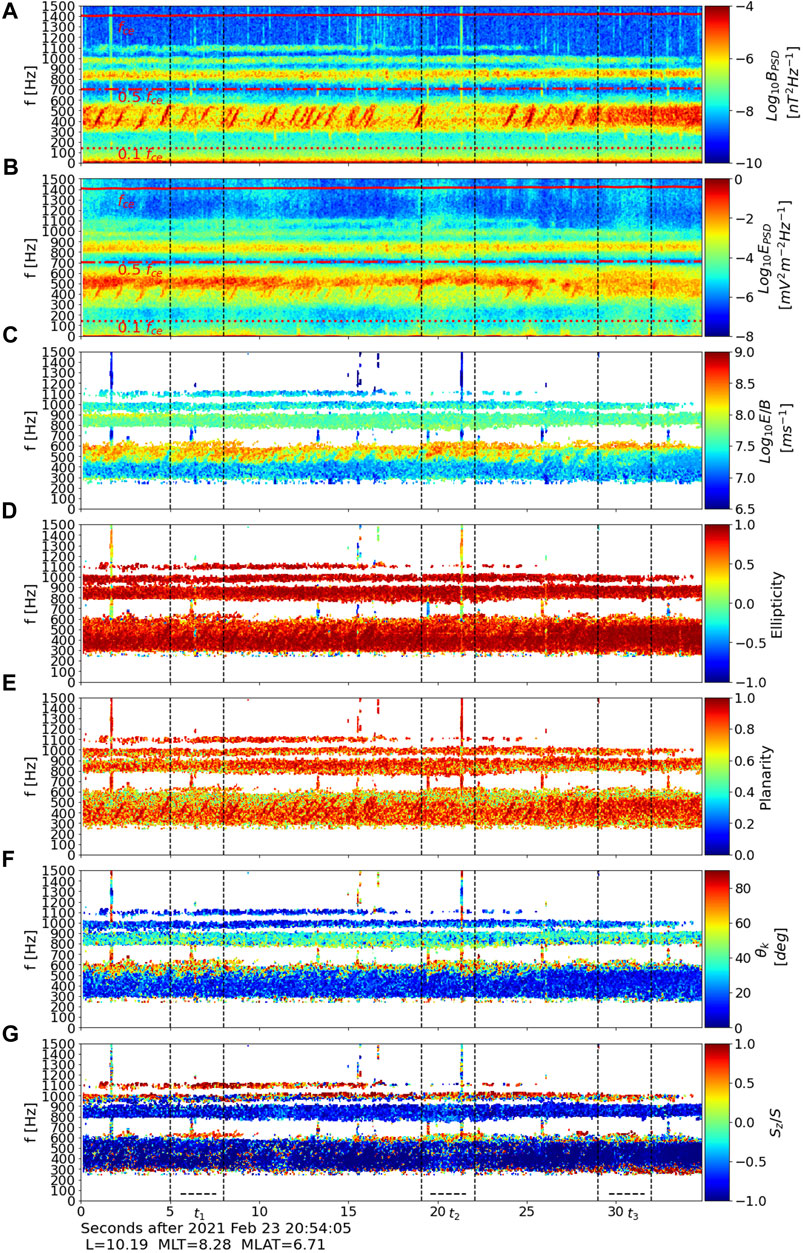
Figure 1. Multiband whistler mode wave event detected by MMS1 on 23 February 2021. Panels show (A) magnetic power spectral density, (B) electric power spectral density, (C)
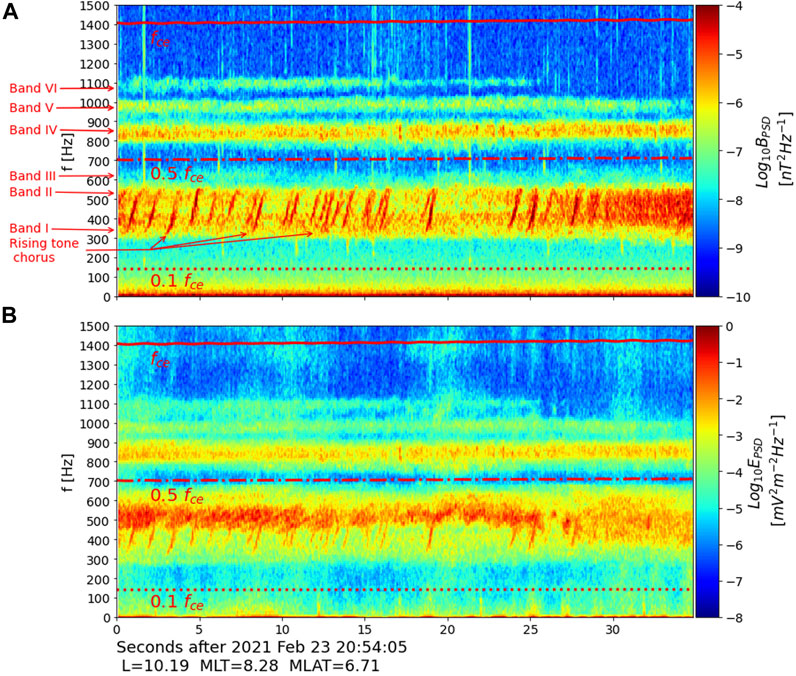
Figure 2. A zoomed-in view of Figure 1A,B displaying the magnetic and electric power spectral densities, respectively. The figure highlights distinct frequency bands and the rising tone chorus of the observed multiband whistler mode wave event.
3 Magnetic amplitude correlation
We discuss here the possible correlation among three bands to investigate the nonlinear coupling between two lower band whistler waves producing an upper band whistler mode wave. In our analysis of the MMS whistler mode wave event, we presented a spectrogram (see Figure 2) that displays three distinct bands: band I, band II, and band IV. For this amplitude correlation analysis, we focus on narrow frequency ranges within these bands with 300 Hz
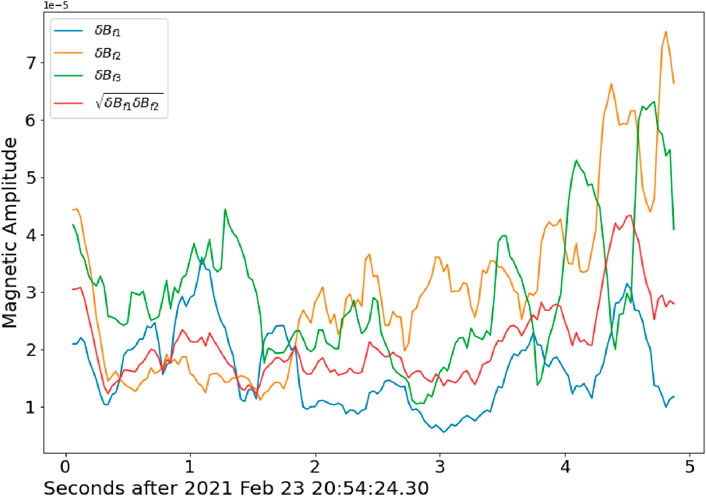
Figure 3. Magnetic amplitude correlation among three bands (band I, band II and band IV). Magnetic amplitude of
4 Wavelet bispectrum
We consider two signals
where the integral is taken over a finite time interval,
Milligen et al. (1995a) further defined wavelet bicoherence by normalizing the wavelet bispectrum. The normalized squared bispectrum is the squared wavelet bicoherence (Milligen et al., 1995a) and can be given by,
Wavelet bicoherence provides values between 0 and 1 and one can measure coupling between two frequencies satisfying resonance conditions for three-wave interactions when the wavelet bicoherence is close to 1. However, Newman et al. (2021) highlighted the difficulty of describing nonlinear interactions based solely on wavelet bicoherence values. This difficulty arises because estimating wavelet bicoherence using Equation 3 does not clarify whether high bicoherence values represent true interactions between oscillatory influences or simply the absence of oscillatory components and related harmonics. Additionally, while wavelet bicoherence provides information about the bispectral content in scale-scale space, it complicates the interpretation of how this spectral content is distributed across different regions in that space. Seeking a solution to this issue, they introduced the wavelet bispectral density (WBD) by suitable normalization of Equation 2, where the integration of spectral densities is performed over a region of time-frequency-frequency space (or time-scale-scale space) to provide bispectral content of that region.
Newman et al. (2021) assumed an inverse relationship between frequency and scale,
for
For defining the wavelet bispectrum, a valid candidate can be represented through the integration of a formula for wavelet bispectral density, whose value at
The normalization factor,
Detailed information about the interpretation of the definition of WBD can be found in Newman et al. (2021).
Note that we are following the methodology and formulae from Newman et al. (2021), so that we are working with a suitably normalized form of the bispectral density. The notation for Equation 6 is slightly different from Equation (46) of Newman et al. (2021) to clarify that it is symmetric under the interchange of
5 Applying wavelet bispectrum to real data
We use the Matlab code for the wavelet bispectral analysis methods developed by Newman et al. (2021), Rowland Adams et al. (2021) to study the time evolution of bispectrum using real data. We first test this code by taking data for published events. Gao et al. (2017) studied nonlinear wave-wave coupling between whistler mode waves by considering a THEMIS D event observed on 04 February 2010 at about L-shell 8. They applied the wavelet bicoherence analysis method as described in Milligen et al. (1995a), Milligen et al. (1995b) to estimate nonlinear interaction phenomena for the considered event. Considering similar data, we apply Newman et al. (2021)’s approach to investigate the WBD. Note that we choose combinations of electric field
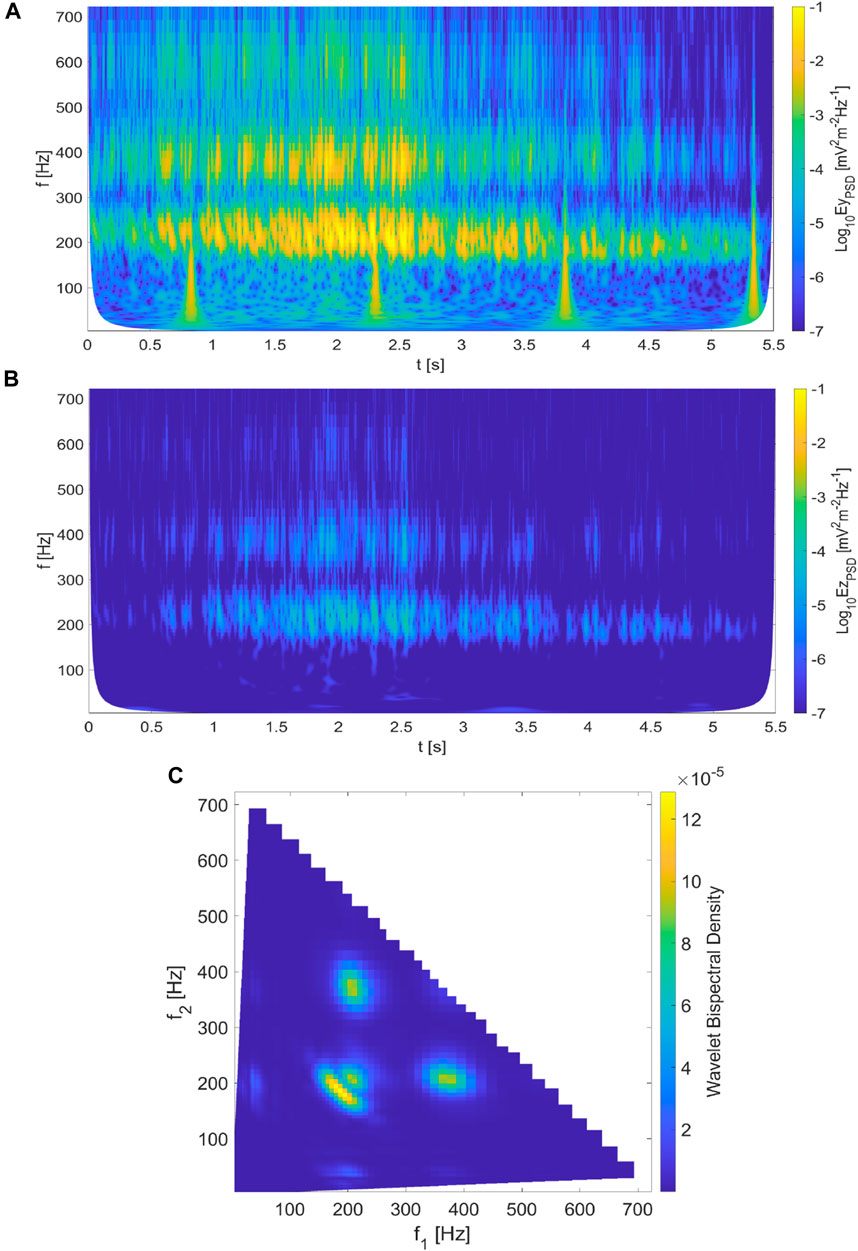
Figure 4. Wavelet analysis of THEMIS D event reported in Gao et al. (2017). Panels (A, B) the
Now, we apply Newman et al. (2021)’s approach to examine the MMS multiband whistler mode wave event observed on 23 February 2021. First, we consider three different time intervals (
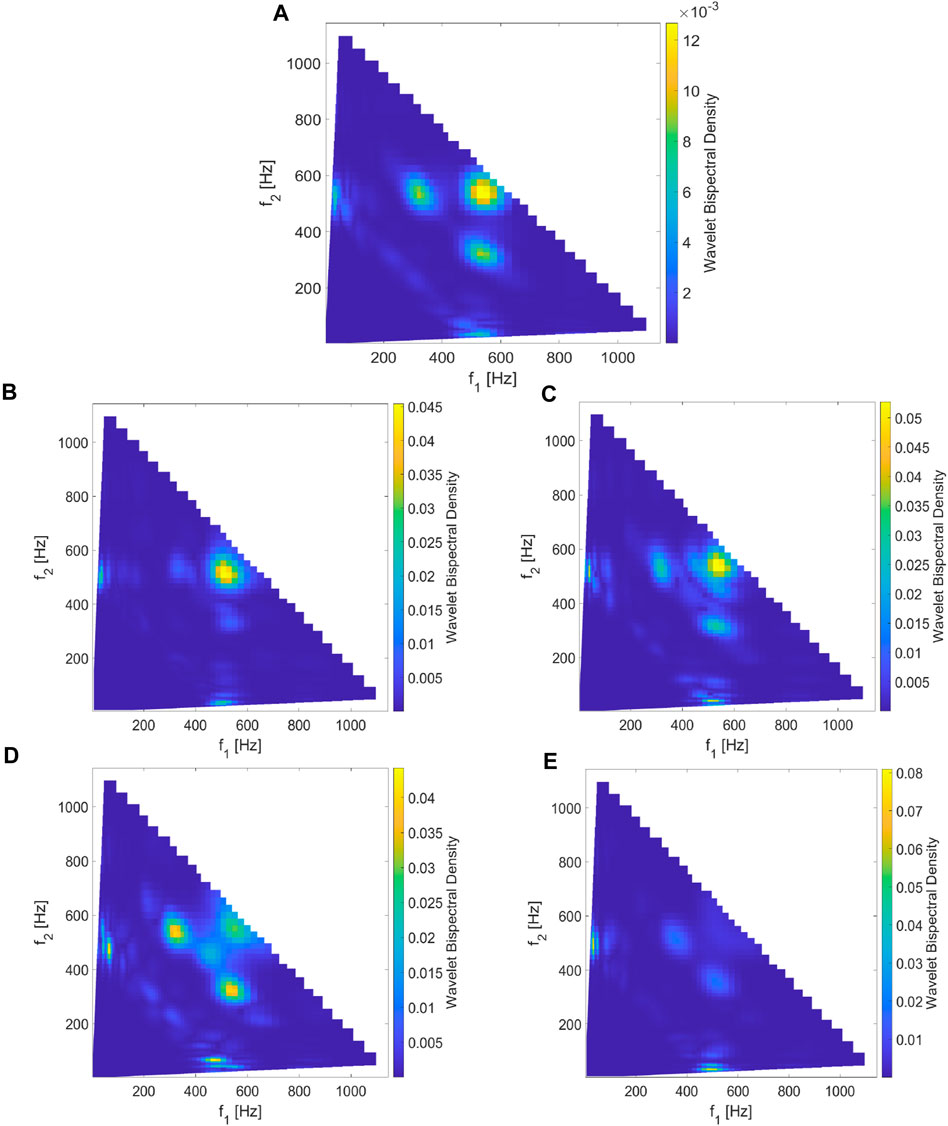
Figure 5. Wavelet bispectral density evaluated in two scenarios: (A) time-averaged bispectral density (units of
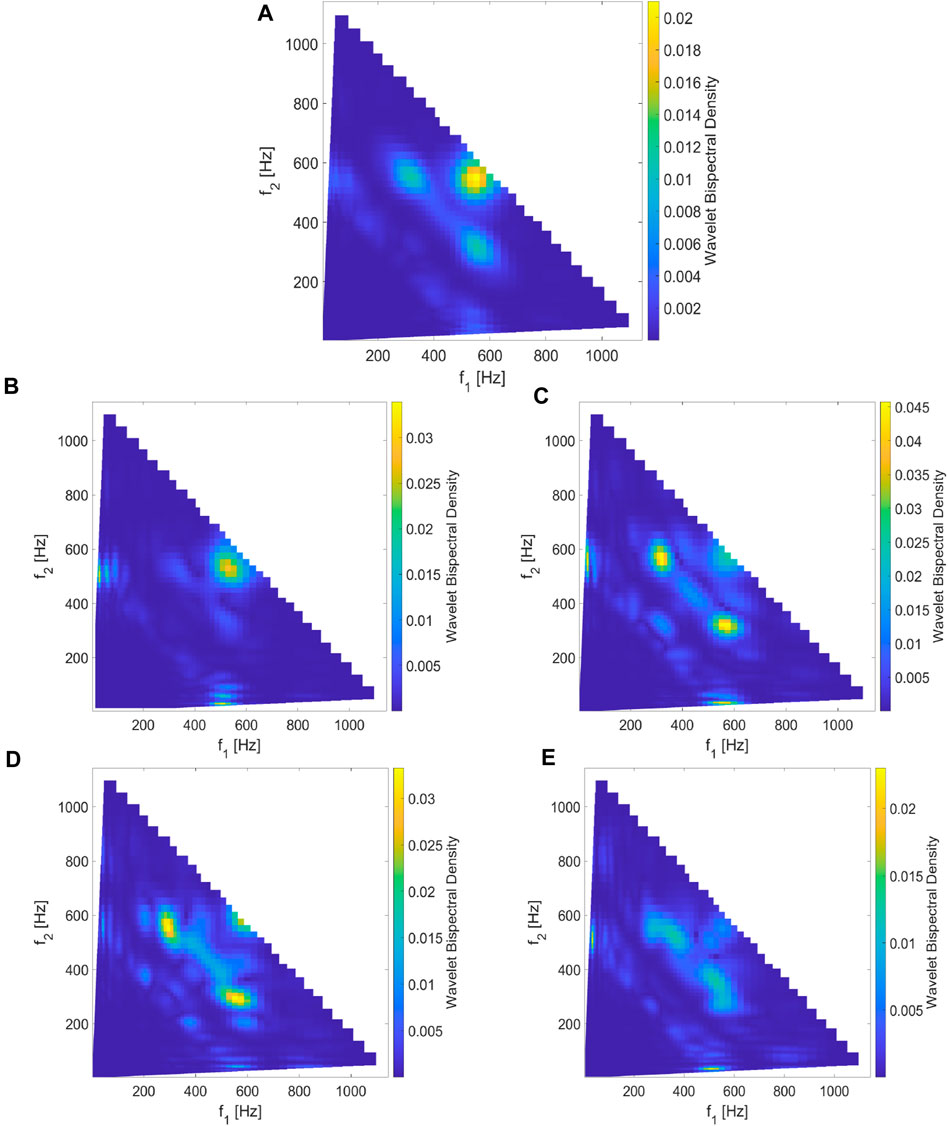
Figure 6. Wavelet bispectral density estimated for another 3 s data (time interval,
Finally, we examine the time interval (
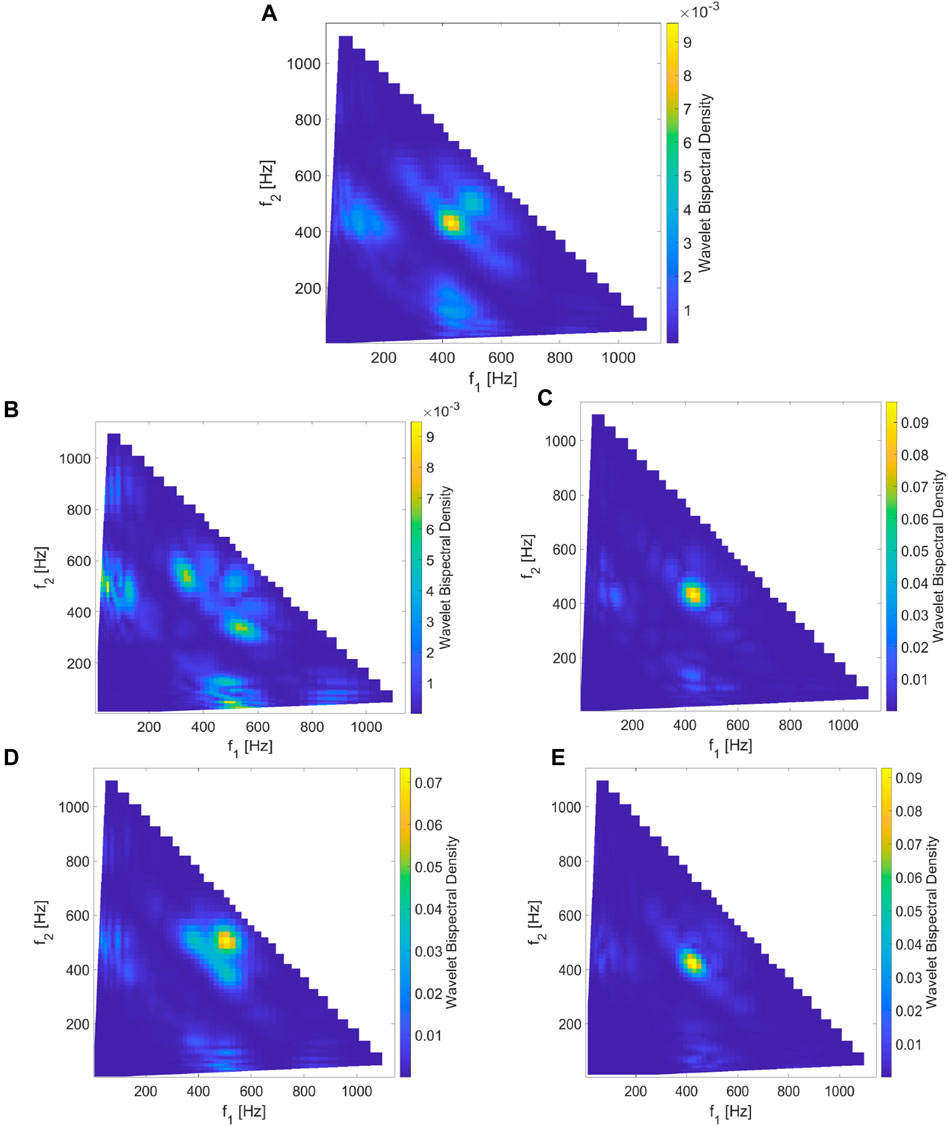
Figure 7. Similar plots to Figure 5, 6, except for the wavelet bispectral density evaluated for the time interval,
6 Discussion
In this paper, we report the presence of a complex multiband whistler mode wave event in the dayside outer magnetosphere using MMS waveform data. This multiband whistler event comprises distinct bands, each of which exhibits distinguishable characteristics. These characteristics have been identified in terms of magnetic power spectral density, electric power spectral density,
The generation mechanism of observed multiband emissions cannot be easily explained with a linear or quasi-linear approach. The intricate characteristics of the wave generation imply that a nonlinear wave interaction mechanism may be more relevant for comprehending such phenomena. To investigate the nonlinear three-wave interaction in the observed multiband whistler event, we employ bispectral analysis on MMS burst mode data for this event. To achieve this, we utilize the wavelet bispectrum analysis method developed by Newman et al. (2021), where they introduced a suitable normalization for the wavelet bispectrum to define the WBD. Note that WBD provides a detailed view of the bispectrum, allowing us to interpret possible nonlinear three-wave interactions that may not be clearly explainable in terms of Fourier bicoherence. WBD also overcomes the limitations of wavelet bicoherence by normalizing the bispectrum in a more efficient manner. The analysis of wavelet bispectral densities in the data for the observed event exhibit several significant peaks in the frequency-frequency space. We identify a peak with a high bispectral density that occurs at a location where the resonance condition for three waves (i.e.,
The propagation direction of the whistler mode waves is particularly important for the occurrence of the nonlinear coupling process, in order to assess the matching conditions necessary for a three-wave interaction. Teng et al. (2018) reported a lower band chorus wave generated by a nonlinear three-wave interaction, where two parent whistler waves and the produced daughter whistler wave propagate in the same direction. Furthermore, Gao et al. (2017) addressed that nonlinear coupling between two oppositely propagating whistler mode lower band waves can produce an upper band whistler wave, which propagates in the same direction as the relatively higher-frequency lower band wave. However, our present study shows that two lower band whistler mode waves (band I and band II) propagating in the same direction can interact nonlinearly and produce an upper band whistler mode wave (band IV), which propagates in the same direction as both of lower band whistler mode waves.
For the observed multiband event, one can think of generating a lower band whistler wave (band I) by nonlinear coupling between two upper band whistler waves (band VI and band IV). Teng et al. (2018) showed that a lower band chorus wave can be generated by two copropagating whistler mode waves by satisfying the matching condition
Our study focuses on the wave-wave coupling phenomena in multiband whistler mode waves. Specifically, we investigate how two lower band whistler mode waves interact to produce an upper band whistler mode wave. To validate this wave-wave coupling mechanism, we also performed a wave vector analysis to determine whether the resonance condition (
In summary, three-wave coupling can explain some of the observed bands, but other processes are required for a full explanation, such as the generation of pump waves (probably by linear instability), the generation of rising tones (through nonlinear resonance processes), and propagation effects. Note that amplitude correlation discussed in Section 3 does not strictly indicate the region where three-wave coupling is operating, so there is a possibility that the bispectrum signature is the result of a three-wave coupling process happening remote to the observation point. This could also explain the variability seen in the three-wave WBD signature. Finally, the observed multiband event will probably require a complex combination of processes to be fully explained.
Data availability statement
Publicly available datasets were analyzed in this study. This data can be found here: https://lasp.colorado.edu/mms/sdc/public/about/.
Author contributions
MS: Conceptualization, Formal Analysis, Investigation, Methodology, Software, Validation, Visualization, Writing–original draft, Writing–review and editing. DB: Project administration, Supervision, Writing–review and editing.
Funding
The authors declare that financial support was received for the research, authorship, and/or publication of this article. This work was funded by the Commonwealth Scholarship Commission in the UK through a Commonwealth PhD Scholarship. This work also received support from UK STFC grant ST/X000974/1.
Acknowledgments
MS acknowledges funding from the Commonwealth Scholarship Commission in the UK and DB acknowledges funding from UK STFC grant ST/X000974/1. This work used MATLAB code which is available at https://doi.org/10.5281/zenodo.5519692. The MMS data used in this study is available at the MMS Science Data Center https://lasp.colorado.edu/mms/sdc/public/about/.
Conflict of interest
The authors declare that the research was conducted in the absence of any commercial or financial relationships that could be construed as a potential conflict of interest.
Publisher’s note
All claims expressed in this article are solely those of the authors and do not necessarily represent those of their affiliated organizations, or those of the publisher, the editors and the reviewers. Any product that may be evaluated in this article, or claim that may be made by its manufacturer, is not guaranteed or endorsed by the publisher.
References
Bale, S. D., Burgess, D., Kellogg, P. J., Goetz, K., Howard, R. L., and Monson, S. J. (1996). Phase coupling in Langmuir wave packets: possible evidence of three-wave interactions in the upstream solar wind. Geophys. Res. Lett. 23, 109–112. doi:10.1029/95GL03595
Bortnik, J., Inan, U. S., and Bell, T. F. (2006). Landau damping and resultant unidirectional propagation of chorus waves. Geophys. Res. Lett. 33, L03102. doi:10.1029/2005GL024553
Bortnik, J., Thorne, R. M., and Meredith, N. P. (2008). The unexpected origin of plasmaspheric hiss from discrete chorus emissions. Nature 452, 62–66. doi:10.1038/nature06741
Burtis, W. J., and Helliwell, R. A. (1969). Banded chorus–A new type of VLF radiation observed in the magnetosphere by OGO 1 and OGO 3. J. Geophys. Res. 74, 3002–3010. doi:10.1029/JA074i011p03002
Burton, R. K., and Holzer, R. E. (1974). The origin and propagation of chorus in the outer magnetosphere. J. Geophys. Res. 79, 1014–1023. doi:10.1029/JA079i007p01014
Chen, R., Gao, X., Chen, H., and Wang, S. (2020). A new generation mechanism of three-band chorus waves in the Earth’s magnetosphere. J. Univ. Sci. Technol. China 50, 1249–1257. doi:10.3969/j.issn.0253-2778.2020.09.004
Contel, O. L., Leroy, P., Roux, A., Coillot, C., Alison, D., Bouabdellah, A., et al. (2016). The search-coil magnetometer for MMS. Space Sci. Rev. 199, 257–282. doi:10.1007/s11214-014-0096-9
Dudok de Wit, T., and Krasnosel’skikh, V. V. (1995). Wavelet bicoherence analysis of strong plasma turbulence at the Earth’s quasiparallel bow shock. Phys. Plasmas 2, 4307–4311. doi:10.1063/1.870985
Ergun, R. E., Tucker, S., Westfall, J., Goodrich, K. A., Malaspina, D. M., Summers, D., et al. (2016). The axial double probe and fields signal processing for the MMS mission. Space Sci. Rev. 199, 167–188. doi:10.1007/s11214-014-0115-x
Fu, X., Gary, S. P., Reeves, G. D., Winske, D., and Woodroffe, J. R. (2017). Generation of highly oblique lower band chorus via nonlinear three-wave resonance. Geophys. Res. Lett. 44, 9532–9538. doi:10.1002/2017GL074411
Fu, X., Guo, Z., Dong, C., and Gary, S. P. (2015). Nonlinear subcyclotron resonance as a formation mechanism for gaps in banded chorus. Geophys. Res. Lett. 42, 3150–3159. doi:10.1002/2015GL064182
Gao, X., Li, W., Thorne, R. M., Bortnik, J., Angelopoulos, V., Lu, Q., et al. (2014). New evidence for generation mechanisms of discrete and hiss-like whistler mode waves. Geophys. Res. Lett. 41, 4805–4811. doi:10.1002/2014GL060707
Gao, X., Lu, Q., Bortnik, J., Li, W., Chen, L., and Wang, S. (2016). Generation of multiband chorus by lower band cascade in the Earth’s magnetosphere. Geophys. Res. Lett. 43, 2343–2350. doi:10.1002/2016GL068313
Gao, X., Lu, Q., and Wang, S. (2017). First report of resonant interactions between whistler mode waves in the Earth’s magnetosphere. Geophys. Res. Lett. 44, 5269–5275. doi:10.1002/2017GL073829
Gao, Z., Zou, Z., Zuo, P., Wang, Y., He, Z., and Wei, F. (2019). Low-frequency hiss-like whistler-mode waves generated by nonlinear three-wave interactions outside the plasmasphere. Phys. Plasmas 26, 122901. doi:10.1063/1.5115542
Hagihira, S., Takashina, M., Mori, T., Mashimo, T., and Yoshiya, T. (2021). Practical issues in bispectral analysis of electroencephalographic signals. Anesth. Analg. 93, 966–970. doi:10.1097/00000539-200110000-00032
Helliwell, R. A. (1969). Low-frequency waves in the magnetosphere. Rev. Geophys. 7, 281–303. doi:10.1029/RG007i001p00281
Kennel, C. F., and Petschek, H. E. (1966). Limit on stably trapped particle fluxes. J. Geophys. Res. 71, 1–28. doi:10.1029/JZ071i001p00001
Kim, Y. C., and Powers, E. J. (1979). Digital bispectral analysis and its applications to nonlinear wave interactions. IEEE Trans. Plasma Sci. 7, 120–131. doi:10.1109/TPS.1979.4317207
Li, W., Thorne, R. M., Bortnik, J., Tao, X., and Angelopoulos, V. (2012). Characteristics of hiss-like and discrete whistler-mode emissions. Geophys. Res. Lett. 39, L18106. doi:10.1029/2012GL053206
Lindqvist, P.-A., Olsson, G., Torbert, R. B., King, B., Granoff, M., Rau, D., et al. (2016). The Spin-Plane Double Probe electric field instrument for MMS. Space Sci. Rev. 199, 137–165. doi:10.1007/s11214-014-0116-9
Macúšová, E., Santolík, O., Cornilleau-Wehrlin, N., Pickett, J. S., and Gurnett, D. A. (2014). Multi-banded structure of chorus-like emission, in 2014 XXXIth URSI general assembly and scientific symposium (URSI GASS). Beijing, China, August 16–23, 2014 (IEEE), 1–4.
Milligen, B. P. V., Hidalgo, C., and Sã¡nchez, E. (1995a). Nonlinear phenomena and intermittency in plasma turbulence. Phys. Rev. Lett. 74, 395–398. doi:10.1103/PhysRevLett.74.395
Milligen, B. P. V., Sánchez, E., Estrada, T., Hidalgo, C., Brañas, B., Carreras, B., et al. (1995b). Wavelet bicoherence: a new turbulence analysis tool. Phys. Plasmas 2, 3017–3032. doi:10.1063/1.871199
Newman, J., Pidde, A., and Stefanovska, A. (2021). Defining the wavelet bispectrum. Appl. Comput. Harmon. Analysis 51, 171–224. doi:10.1016/j.acha.2020.10.005
Ni, B., Li, W., Thorne, R. M., Bortnik, J., Ma, Q., Chen, L., et al. (2014). Resonant scattering of energetic electrons by unusual low-frequency hiss. Geophys. Res. Lett. 41, 1854–1861. doi:10.1002/2014GL059389
Rowland Adams, J., Piddle, A., Newman, J., and Stefanovska, A. (2021). Bispectrum testing. doi:10.5281/zenodo.5519691
Russell, C. T., Anderson, B. J., Baumjohann, W., Bromund, K. R., Dearborn, D., Fischer, D., et al. (2016). The magnetospheric Multiscale magnetometers. Space Sci. Rev. 199, 189–256. doi:10.1007/s11214-014-0057-3
Santolík, O., Gurnett, D. A., Pickett, J. S., Chum, J., and Cornilleau-Wehrlin, N. (2009). Oblique propagation of whistler mode waves in the chorus source region. J. Geophys. Res. 114, A00F03. doi:10.1029/2009JA014586
Santolík, O., Parrot, M., and Lefeuvre, F. (2003). Singular value decomposition methods for wave propagation analysis. Radio Sci. 38, 1010. doi:10.1029/2000RS002523
Santolík, O., Pickett, J. S., Gurnett, D. A., Menietti, J. D., Tsurutani, B. T., and Verkhoglyadova, O. (2010). Survey of Poynting flux of whistler mode chorus in the outer zone. J. Geophys. Res. Space Phys. 115, A00F13. doi:10.1029/2009JA014925
Schriver, D., Ashour-Abdalla, M., Coroniti, F. V., LeBoeuf, J. N., Decyk, V., Travnicek, P., et al. (2010). Generation of whistler mode emissions in the inner magnetosphere: an event study. J. Geophys. Res. Space Phys. 115, A00F17. doi:10.1029/2009JA014932
Summers, D., Omura, Y., Nakamura, S., and Kletzing, C. A. (2014). Fine structure of plasmaspheric hiss. J. Geophys. Res. Space Phys. 119, 9134–9149. doi:10.1002/2014JA020437
Taubenschuss, U., Santolík, O., Breuillard, H., Li, W., and Contel, O. L. (2016). Poynting vector and wave vector directions of equatorial chorus. J. Geophys. Res. Space Phys. 121 (11), 11–928. doi:10.1002/2016JA023389
Teng, S., Zhao, J., Tao, X., Wang, S., and Reeves, G. D. (2018). Observation of oblique lower band chorus generated by nonlinear three-wave interaction. Geophys. Res. Lett. 45, 6343–6352. doi:10.1029/2018GL078765
Tsurutani, B. T., and Smith, E. J. (1974). Postmidnight chorus: a substorm phenomenon. J. Geophys. Res. 79, 118–127. doi:10.1029/JA079i001p00118
Tsurutani, B. T., and Smith, E. J. (1977). Two types of magnetospheric elf chorus and their substorm dependences. J. Geophys. Res. 82, 5112–5128. doi:10.1029/JA082i032p05112
Keywords: earth’s magnetosphere, magnetospheric multiscale mission, multiband whistlers, wavelet bispectrum, wave-wave coupling
Citation: Shah MG and Burgess D (2024) Estimating the wavelet bispectrum of multiband whistler mode waves. Front. Astron. Space Sci. 11:1455400. doi: 10.3389/fspas.2024.1455400
Received: 26 June 2024; Accepted: 23 August 2024;
Published: 11 September 2024.
Edited by:
Ivan Y. Vasko, The University of Texas at Dallas, United StatesReviewed by:
Ilya Kuzichev, New Jersey Institute of Technology, United StatesXiaofei Shi, University of California, Los Angeles, United States
Copyright © 2024 Shah and Burgess. This is an open-access article distributed under the terms of the Creative Commons Attribution License (CC BY). The use, distribution or reproduction in other forums is permitted, provided the original author(s) and the copyright owner(s) are credited and that the original publication in this journal is cited, in accordance with accepted academic practice. No use, distribution or reproduction is permitted which does not comply with these terms.
*Correspondence: M. G. Shah, bWQuc2hhaEBxbXVsLmFjLnVr
 M. G. Shah
M. G. Shah D. Burgess
D. Burgess